Basketball Defense - the 1-1-3 Zone Defense
By Dr. James Gels, From the Coach’s Clipboard Basketball Playbook"Helping coaches coach better..."
Disclosure: This page contains affiliate links, which means that Coach's Clipboard receives a small commission (at no cost to you) if you make a purchase using these links.
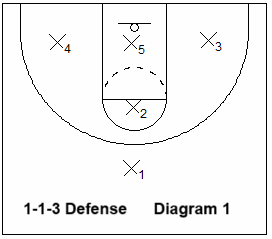
The 1-1-3 match-up zone defense was pioneered by coach Lute Olson and further developed by coach Mike Dunlap. Chances are that your opponent rarely sees the 1-1-3 defensive set, and thus it can be confusing to them. The keys to its success are (1) tight ball-pressure, (2) quick defensive rotations, and (3) rebounding. If you fail in any one of these three facets, this defense will fail.
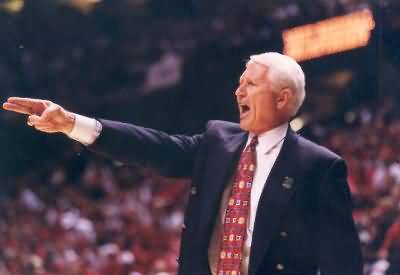
Coach Lute Olson

Coach Mike Dunlap
If you spend most of your time just studying and drilling the rotations below, and neglecting the importance of man-to-man ball pressure and rebounding, this defense won't work.
Man-to-Man Principles
Ball-Pressure
Very tight ball-pressure is taught with "in your face" contact, trying to make the offensive player reverse pivot and turn his back to the basket... or force a bad pass, or force a poor dribbler to dribble.Stance and Hands
The stance is wide-based with feet wide, butt down and back straight. Both hands are up and out, never low. Because we are always forcing to the baseline, the close-out is on the high hip side, with the defender's head inline with the ball and the basket.Jump to the Ball
Defenders move as the ball moves, on the flight of the ball, not when it gets to its destination. As soon as the ball leaves the passer's hands, the defenders are already stepping toward the ball. This is crucial for the quick rotations that are required, and to impede cutters.Communication
As with any good defense, players must talk and communicate with each other. Instead of the repetitive "ball, ball, ball, ball...", one good loud "ball!" works better, and most actions can be just one word.Close-Outs
Close-out very aggressively with both hands high, and make contact with the offensive player. Be physical. Coach Dunlap uses the expression "hit and back off" - make initial contact, and drop back a little. Close-out on the high hip side, as we want to deny the middle and force baseline. If the offensive player gets around the defender on the baseline side, live with it and stop the ball down lower.Rebounding
Rebounding is one of the three keys, along with ball-pressure and quick rotations. When the shot goes up, the on-ball defender blocks out the shooter, the three inside defenders form a rebounding triangle, and the other player sprints to the weakside. 70% of missed wing/corner shots go long to the opposite side. See diagram 2.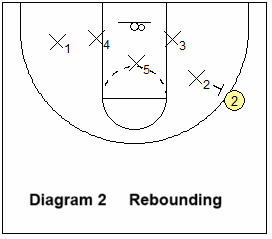
Sideline Pins
As mentioned, force the ball toward the baseline and keep it out of the middle and the high post. Prevent ball-reversal. Close-out on the high hip. If the ball is dribbled from the wing to the middle, aggressively trap the dribbler, or use the "run and jump" technique (discussed below).
Rotations
Simplisticly, when the ball is on the top (above the free-throw line), coach Olson used to say that one guard defender has the ball and the other guard defender has the high post. X1 picks up the ball near half court with pressure trying to force the ball to one side (often the left side if the offense favors going right).Dribble to the wing
When the point guard dribbles to the wing, X1 just stays with him as the others rotate over (diagram 4).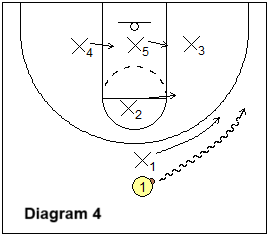
Ball passed to the wing
When the pass goes from the top to the wing, the rotation depends on "counting the sideline alley". The sideline alley (yellow) is the area within about 6 feet or so of the sideline (diagram 5). If there is only one offensive player in the sideline alley, the low outside, ballside defender (X3) closes-out and pressures the ball. X2 moves to the ballside elbow and X1 drops to the weakside elbow.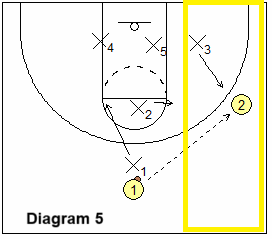
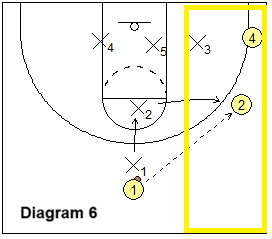
Diagram 6 shows that if there are two offensive players in the sideline alley, then X2 closes-out and pressures the ball, as X1 drops to the high post.
Wing to corner pass
Diagram 7 shows the pass to the corner. X3 pressures the ball. X2 could follow down and trap the corner.
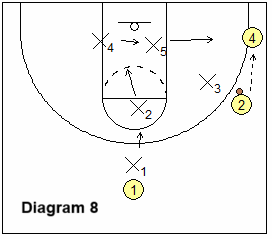
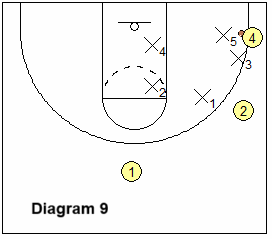
Now let's back up and look at diagram 8. At times there will be rotation errors, and in this case even though there were two offensive players in the sideline alley, X3 came out on the wing O2, leaving O4 open in the corner. Here X5 sprints out to the corner, as X4 slides to the ballside block and X2 drops into the paint, while X1 covers the high post. Diagram 9 shows the corner trap continuation from diagram 8.
Whenever we trap (diagram 9), we always have one defender (X4) guarding the basket ("low hole") and one (X2) defending the high post ("high hole").
Wing to point pass
Diagram 10 shows the pass from the wing back to the point. X1 pressures the ball. X2 has the high post.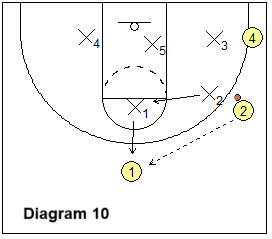
Wing dribble to baseline
Diagram 11 shows X4 pressuring the ball on the wing. O3 dribbles baseline, and X4 stays with the ball.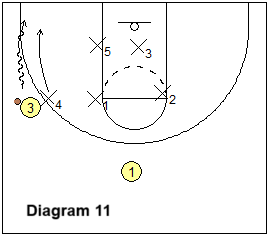
Corner dribble to wing
Diagram 12 shows X4 pressuring the ball in the corner. O3 dribbles to the wing. X4 stays with the ball up to about the elbow extended, calls "Switch!", and X1 takes the ball. X4 quickly retreats to the low post.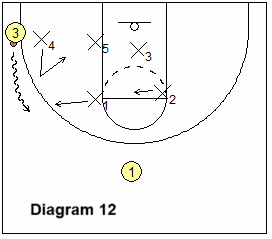
Defending the high post/elbows
This is crucial. If the offense can get the ball into high post at will, your defense will fail. You must really drill this in practice. If there are two offensive players at the elbows (e.g. 1-4 set or horns set), they must be defended by either two guards, or one guard and one forward defender (X3 or X4) - diagram 13.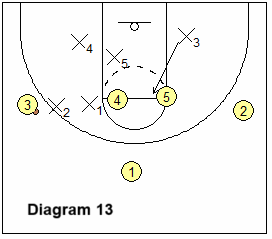
Defending the low post
If the low post player is strong and a great scorer, full-front the low post (diagram 14) when the ball is on the wing. And you can double team with the ballside elbow defender (X2). If he is just an average post player, play behind or half-front. You can play him 1-on-1 (especially if they have good outside shooters), or double team (diagram 15) with the ballside high post defender (X2).If the ball goes to the corner (diagram 16), X5 must come out to defend. Here the elbow defender X2 sprints down to arm front and deny the low post. X1 slides over to the ballside elbow.
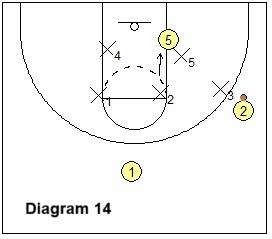
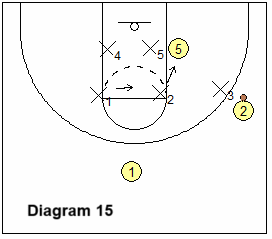
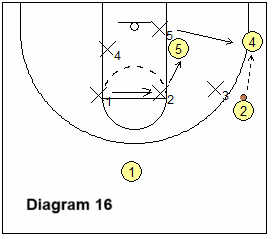
Corner to opposite wing skip pass
Diagram 17 - O4 skip passes to O1. The nearest defender (X1) always takes the ball, and the others rotate as shown.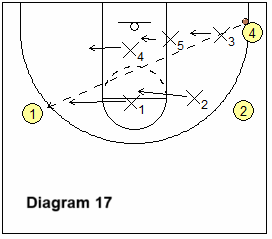
Wing to opposite corner skip pass
Diagram 18 - O1 skip passes to O4. The low outside defender X3 takes the ball, and the others rotate as shown.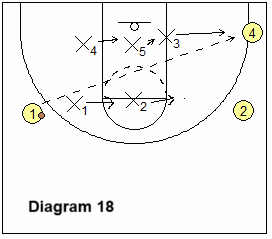
Wing to opposite wing skip pass
Diagram 19. If there is an offensive player at the high post (O4), then the outside opposite low defender (X3) closes-out on the ball. X2 steps around O4 to deny, as X1, X4 and X5 rotate as shown.Diagram 20. If the high post is empty, X2 closes-out on the ball, as X1 slides to the high post.
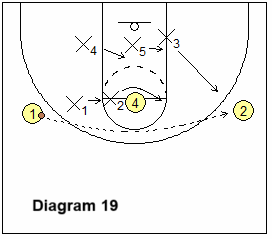
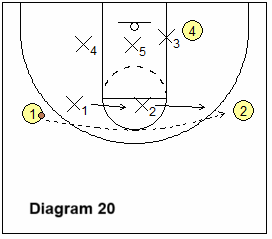
Stopping middle dribble-penetration
We have to keep the ball out of the middle, so we close-out on the wing player's high hip and force baseline. But there will be times when our wing defender gets beaten by a middle dribble. Here, we stunt, stop and trap the dribbler using "run and double" or "run and jump" principles.Diagram 21 shows a run and double (trapping the ball). Diagram 22 shows a run and jump, where X2 stops and takes the ball, and X1 slides under to X2's previous position (X2 calls "Switch!").
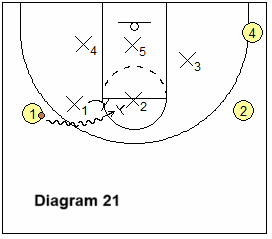
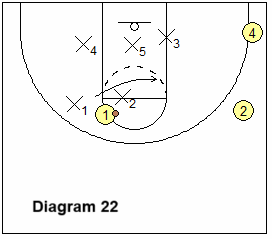
Trapping
We trap, not only to harass and get a turnover, but also to keep the offense out of high post/elbows, and corner/short corner areas... to discourage them from attacking those spots. If they know they are going to get harassed and trapped in those areas, hopefully they will avoid the high post and short corners, making our job easier.Whenever we trap, there are two defenders on the ball, and we always have two defenders guarding the high post ("high hole") and the basket ("low hole").
We have already seen how to trap the corners (diagram 9). The same rotations are used for trapping the short corner. We have just looked at the run and double trap for trapping the high post (diagram 21). We have discussed trapping the low post.
Diagram 23 shows a trap on the wing created by X3 sprinting up to trap with X2. X1 is the high hole, and X5 is the low hole.


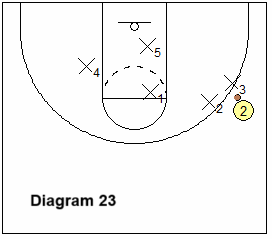
In summary... For this defense to be effective, you must:
- apply aggressive ball-pressure and good man-to-man principles
- jump to the ball and rotate quickly, and master the rotations so they become habit
- rebound